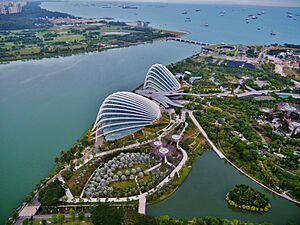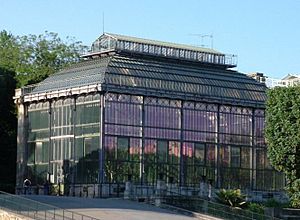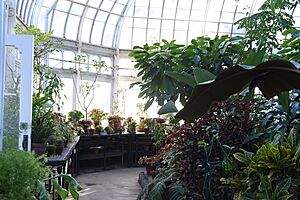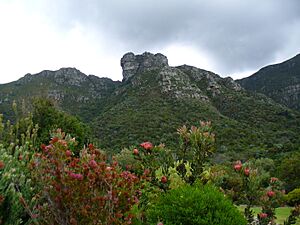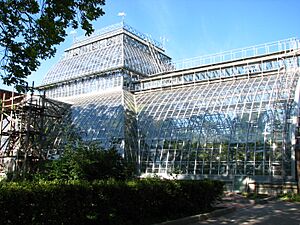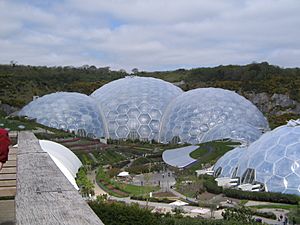Botanical garden facts for kids
A botanical garden is like a living museum for plants! It's a special garden that collects and grows many different kinds of plants. These plants are carefully looked after and studied for science, conservation, and education. Each plant usually has a label with its botanical name, which is its scientific name.
Botanical gardens often have unique plant collections. You might find areas just for cacti and other succulent plants, or herb gardens. Some gardens focus on plants from specific parts of the world. Many also have glasshouses or special covered areas for plants that need warm or cool climates, like tropical plants or alpine plants.
Most botanical gardens are open to the public. They often offer fun activities like guided tours, workshops, and educational displays. You might even see art exhibitions, concerts, or plays there!
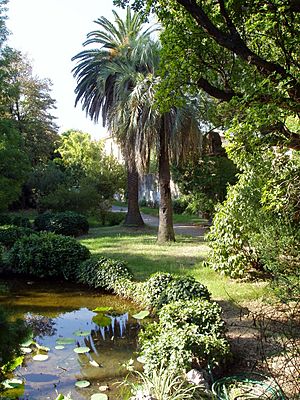

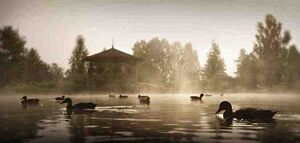
Many botanical gardens are connected to universities or science groups. They often have herbaria (collections of dried plants) and research programs. Their main job is to keep documented collections of living plants. This helps with scientific research, protecting plants, showing them off, and teaching people. The staff usually includes botanists (plant scientists) and skilled gardeners.
Some botanical gardens even offer courses in growing plants (horticulture) or studying plants (botany). They also provide chances for students to learn and do research using their amazing plant collections.
Contents
What is a Botanical Garden?
A botanical garden is more than just a pretty park. It's a place where plants are organized and cared for scientifically. They are usually labeled and open to everyone for fun, learning, and research.
A good way to think about it is: a botanical garden is a place that keeps collections of living plants. These collections are used for scientific research, protecting plant species, showing plants to the public, and teaching people about them.
Experts from Cornell University described a botanical garden in 1976. They said it's a place with trained staff that manages a living plant collection for education and research. It might also have libraries, herbaria, labs, and museums. Each garden has its own special interests based on its staff, location, and funding. It's not just a pretty garden or a park with labels. The main goal is to gain and share knowledge about plants.
Why are Botanical Gardens Important?
Every botanical garden has its own special focus. In the 1800s, a director of the Royal Botanic Gardens, Melbourne, named Ferdinand von Mueller, said that botanical gardens must be mainly scientific and educational.
Here are some of the important things botanical gardens do:
- They provide plants for scientific research.
- They show how diverse plants are in their shapes and uses.
- They display plants from specific regions, including local ones.
- They grow plants for their seeds or because they are rare.
- They grow important timber trees.
- They show plants that are important for the economy.
- They have glasshouses for plants from different climates.
- All plants are carefully labeled.
- They keep records of plants and how they grow.
- They publish lists of their plants.
- They have research facilities.
- They study how plants are classified (plant taxonomy).
- They show examples of different types of plant life.
- They help educate students.
- They have a herbarium (dried plant collection).
- They help introduce new ornamental and other plants to people.
- They study plant chemistry.
- They report on how plants affect farm animals.
- They often have people who go out to collect plants in nature.
Botanical gardens have always changed with the times. In the past, they were mainly for doctors and botanists. Now, they also focus on beautiful plants and the general public. They help people understand how human actions affect the Earth's ecosystems. They teach us about the importance of conservation and living in a way that protects nature for the future.
Global Network of Gardens
Today, there are about 1,800 botanical gardens and arboreta (gardens focused on trees) in about 150 countries. Most are in cooler parts of the world. About 550 are in Europe, and 200 are in North America. More and more are opening in East Asia. These gardens welcome around 300 million visitors each year.
Historically, botanical gardens shared plants by publishing lists of seeds. This helped them exchange plants and information. This system still exists today, but with care to avoid spreading invasive species or taking plants unfairly.
Organizations like Botanic Gardens Conservation International (BGCI) help coordinate botanical gardens worldwide. Their goal is to help gardens protect plant diversity for people and the planet. There are also regional groups, like the American Public Gardens Association in the United States.
History of Botanical Gardens
The story of botanical gardens is closely tied to the story of botany (the study of plants). Early botanical gardens in the 1500s and 1600s were mostly for medicinal plants. But over time, they started to show off beautiful, strange, and important plants brought back from faraway lands.
In the 1700s, they became more about teaching. They showed the latest ways to classify plants. By the 1800s and 1900s, gardens combined special collections with general displays of both horticulture (gardening) and botany.
Early Gardens
The idea of "scientific" gardens for studying plants goes back a long time. Modern botanical gardens began when universities in Italy in the 1500s started having botany professors. These professors would look after gardens of medicinal plants.
Ancient Grand Gardens
Ancient royal gardens in places like ancient Egypt, Mesopotamia, and China had plants collected from special trips. Around 2800 BCE, the Chinese Emperor Shen Nung sent people to find plants for medicine or trade. The gardens in ancient Mexico, like those in Tenochtitlan, also impressed Spanish explorers. These gardens had many more medicinal plants than European gardens at the time.
Early gardens in Islamic Spain, like the 11th-century Huerta del Rey garden in Toledo, were similar to later botanical gardens. Many of their plants were collected on expeditions to other countries.
Physic Gardens
Botanical gardens grew out of "physic gardens." These gardens mainly grew herbs for medicine, research, and experiments. In Europe, Aristotle is said to have had a physic garden in Athens. This garden was used for teaching and studying plants.
The gardens that came before modern botanical gardens were often found in medieval monasteries. These gardens had areas for vegetables and special sections for labeled medicinal plants. These were called physic gardens. Charlemagne even listed 73 herbs to be grown in these gardens. In 1447, Pope Nicholas V set aside part of the Vatican for medicinal plants. This helped lead to the university gardens in Padua and Pisa in the 1540s. Many early botanical gardens were started by doctors.
European Gardens (1500s-1600s)
In the 1600s, botanical gardens started to help people learn more about plants. The first true botanical gardens were linked to universities and medical schools. They were used for teaching and research. The people in charge of these gardens were often famous botany professors. This helped botany become its own science, separate from medicine.
Italian Beginnings
The first botanical gardens in Southern Europe were connected to university medical schools in Italy. These included gardens in Orto botanico di Pisa (1544), Orto botanico di Padova (1545), and Orto Botanico di Firenze (1545). Here, doctors taught about the medicinal plants grown in the gardens. The invention of printing and the first plant books (herbals) helped students learn even more.
Spreading North
The idea of these Italian gardens spread across Europe. Some early gardens included Leipzig Botanical Garden, Germany (1543); Hortus Botanicus Leiden, Netherlands (1590); and University of Oxford Botanic Garden, England (1621). Others were the Chelsea Physic Garden, England (1673); and Jardin des Plantes, Paris (1635).
Birth of Plant Science
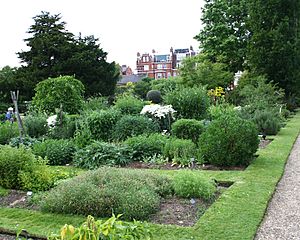
During the 1500s and 1600s, new plants arrived in these European gardens from Eastern Europe and Asia. Plant experts could easily study them there. For example, Carolus Clusius described many Asian plants. He was the director of the Botanical Garden of the University of Vienna and later Hortus Botanicus Leiden. Clusius helped start the Dutch tulip industry. His detailed plant lists helped recreate the Leyden garden.
In the late 1600s, the Paris Jardin des Plantes became a major center for new plants. In England, the Chelsea Physic Garden was founded in 1673. It had heated greenhouses. In the 1700s, under Philip Miller, it became the world's best-stocked botanical garden. Its seed-sharing program, started in 1682, still runs today.
The 1700s: Exploration and Classification
Gardens and Orangeries
As trade by sea grew, more and more plants were brought to Europe from distant lands. These plants were proudly shown in wealthy private estates, plant nurseries, and public botanical gardens. Heated glasshouses called "orangeries" became common in many gardens.
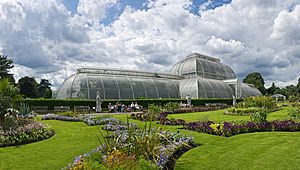
The Royal Botanic Gardens, Kew in London were founded in 1759. They started as a physic garden. Gardens like Kew and the Real Jardín Botánico de Madrid (1755) were set up to grow new species from trips to tropical areas. They also helped start new tropical botanical gardens. From the 1770s, official plant hunters joined amateur collectors. These gardens grew thanks to plants sent back from European colonies around the world.
British gardeners were bringing many woody plants from North America. Growing plants became very popular. Sir William Jackson Hooker and Sir Joseph Banks at Kew led many plant-hunting trips. They sent collectors to places like South Africa, Australia, China, and Brazil. Kew became a major center for exchanging plants for the British Empire. From its beginning, Kew has been a great example of a botanical garden. It's known worldwide for its scientific work, teaching, and public programs.
In 1728, John Bartram started Bartram's Garden in Philadelphia. It was one of the first botanical gardens in North America. Today, it's a historical site with old and new plants, plus historical farm buildings.
How Plants Were Classified
Many new plants needed to be described. In 1753, Carl Linnaeus created the system of binomial nomenclature. This system gives each plant a two-part scientific name, which made listing plants much easier. Dried plant specimens, called herbaria, were used to confirm plant names. These collections were often found in buildings connected to botanical gardens. Many gardens then had "order beds" to show the new classification systems. Botanical gardens became scientific collections. Scientists published descriptions of new exotic plants, often with beautiful illustrations. Gardens moved away from just medicinal uses and focused more on science and beauty.
The 1800s: Global Expansion
The late 1700s and early 1800s saw many tropical botanical gardens being built. These were used by the British and Dutch to help their colonial expansion for trade and business. This was also when Joseph Banks collected plants during Captain James Cook's trips around the world.
Tropical Gardens
Today, there are about 230 tropical botanical gardens, many in Asia. The first tropical garden was the Pamplemousses Botanical Garden in Mauritius, started in 1735. It first provided food for ships, but later tested and shared many important economic plants. Other early tropical gardens included the Saint Vincent and the Grenadens Botanic Gardens (1764) and the Acharya Jagadish Chandra Bose Botanical Garden in Calcutta, India (1786).
Other gardens were built in Brazil (Rio de Janeiro Botanical Garden, 1808), Sri Lanka (Botanic Gardens of Peradeniya, 1821), Indonesia (Bogor Botanical Gardens, 1817), and Singapore (Singapore Botanical Gardens, 1822). These gardens greatly impacted the economies of these countries, especially with new foods and medicines. For example, bringing rubber trees to the Singapore Botanic Garden started the important rubber industry in the Malay Peninsula.

These gardens also explored local plants for their economic value. Many crop plants were introduced through these gardens, often with help from European gardens like Kew. These included cloves, tea, coffee, cinchona, sugar, cotton, and palm oil. The rubber plant was brought to Singapore this way. The exchange of plant material between temperate and tropical gardens helped create the wide range of crops grown in tropical regions today.
Temperate Gardens
The first botanical gardens in Australia were founded in the early 1800s. These included the Royal Botanic Gardens, Sydney (1816) and the Royal Botanic Gardens, Melbourne (1845). They were mainly set up to grow plants for economic use and to help plants from other climates adapt.
South Africa has 10 national botanical gardens. The oldest is the 1851 Durban Botanic Gardens. The Kirstenbosch National Botanical Garden (1913) is the most famous. It covers 36 hectares, with another 528 hectares of mountainside. The Stellenbosch University Botanical Garden (1922) is South Africa's oldest university botanical garden.
In the United States, Presidents George Washington, Thomas Jefferson, and James Madison dreamed of a national botanical garden. This led to the founding of the United States Botanic Garden in 1820, next to the Capitol in Washington DC. In 1859, the Missouri Botanical Garden was founded. It's one of the world's top gardens for tropical plants.
Russia's botanical gardens include the Moscow University Botanic Garden (1706), started by Tsar Peter the Great, and the Saint Petersburg Botanical Garden (1714).
The 1900s: Community and Conservation
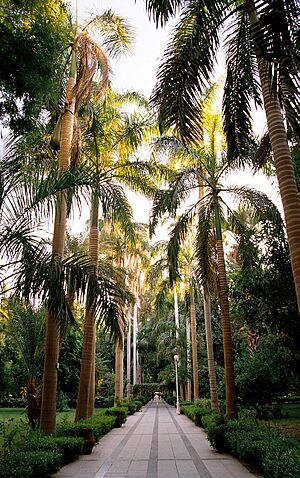
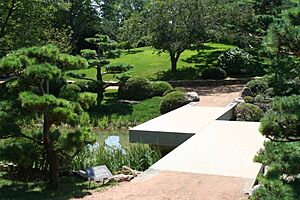
City Gardens
Many city or municipal botanical gardens were started in the 1800s and 1900s. These gardens didn't always have scientific research programs. But they were great for growing plants, and the plants were often labeled. They exchanged seeds with other gardens. Sometimes, they became more like beautiful parks.
Engaging the Public
In the second half of the 1900s, botanical gardens became better at teaching and serving visitors. They started to offer many different things. Displays often included exhibits on evolution, ecology, or plant classification. They also had beautiful flowerbeds, plants from different parts of the world, and special collections of plants like bamboos or roses. Glasshouses held tropical plants, alpine plants, cacti, and orchids. Traditional herb gardens and medicinal plants were still popular.
Gardens like the Palmengarten in Frankfurt, Germany (1869), known for its orchids and succulent plants, became very popular. As governments gave less money, gardens started to host more public events to earn money. These included music, art shows, special plant exhibitions, theater, and movies. "Friends" organizations and volunteer guides also became common.
Protecting Plants
Protecting plants and historical landscapes became very important in the 1900s. Some gardens created separate areas to display native plants. In the 1970s, gardens focused on plant conservation. The Botanic Gardens Conservation Secretariat was set up in 1987 to help gardens worldwide protect plants. It keeps a list of rare and endangered species in garden collections. Many gardens keep "ex situ" collections. This means they preserve plants outside their natural homes. They might store seeds at low temperatures or grow living plants. These collections are often grown with the goal of putting them back into their original habitats.
The 2000s: New Focus
Modern Gardens
Botanical gardens continue to be built in the 2000s. For example, the first botanical garden in Oman is planned to be one of the largest in the world. It will have a huge glasshouse with a "cloud forest." China has also built many new botanical gardens recently. However, in some developed countries, many gardens have closed because they don't have enough money, especially those connected to universities.
Goals and Plans
The Center for Plant Conservation in St Louis, Missouri, helps protect native North American plant species. Their 2006 plan for plant conservation aims to document and protect plant diversity. It also seeks to use this diversity wisely, teach the public about plants, and build support for conservation.
A recent review in 2024 noted that botanical gardens are playing bigger roles in conservation and research. Many new gardens have been created since 1950. The review said gardens are "reinventing" themselves to focus on conservation, sustainability, and connecting with people. It also noted that gardens are working on "decolonizing" their practices and taking on "new socio-environmental missions."
A 2023 review by Chinese botanists also noted the long history of botanical gardens. They said gardens have always changed to meet new needs. Now, their main goal is to protect plants outside their natural homes.
Botanical gardens need to find a balance. They want to be peaceful places, but also need to provide information and services for visitors. These services, like restaurants and gift shops, can bring noise and trash. Sometimes, beautiful landscaping can compete with scientific goals. Today, science often takes second place. Some gardens are now historical sites. They face constant demands for new exhibits and environmentally friendly management.
See also
 In Spanish: Jardín botánico para niños
In Spanish: Jardín botánico para niños
- Herb farm
- List of botanical gardens
- Plant collecting
- National Public Gardens Day
- Botanical and horticultural library



